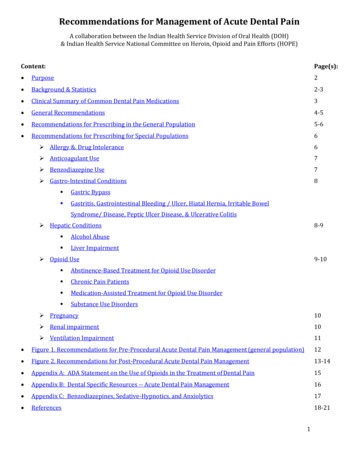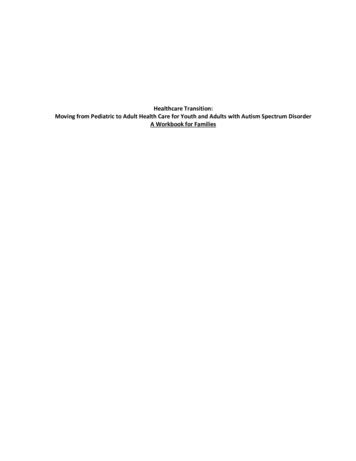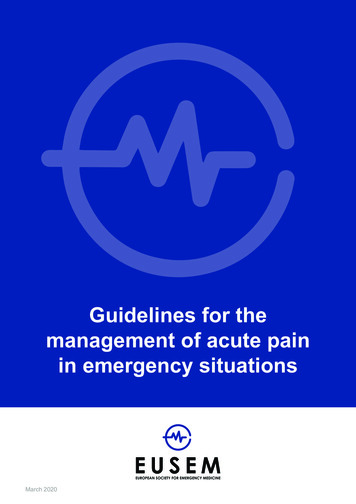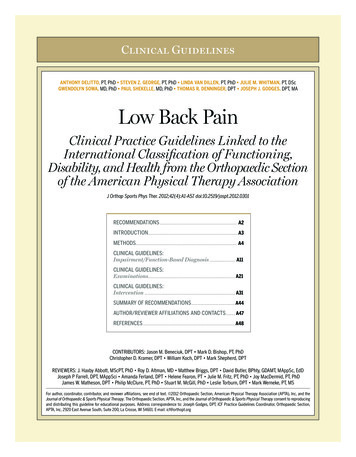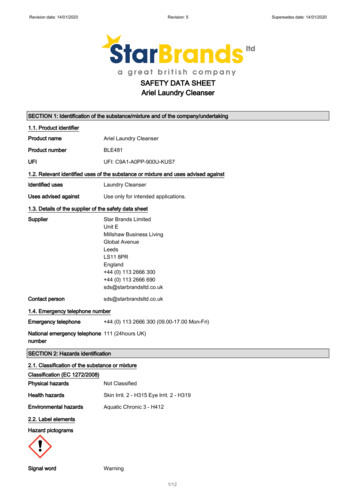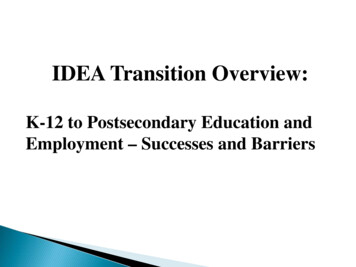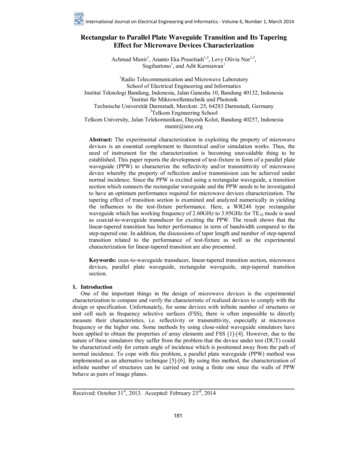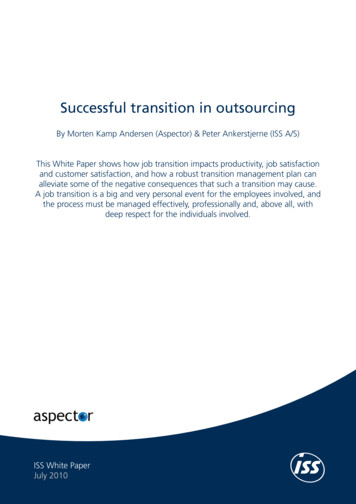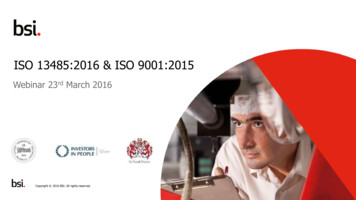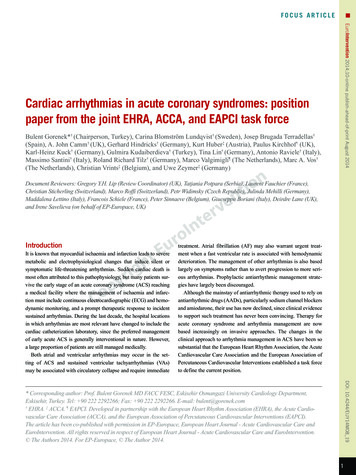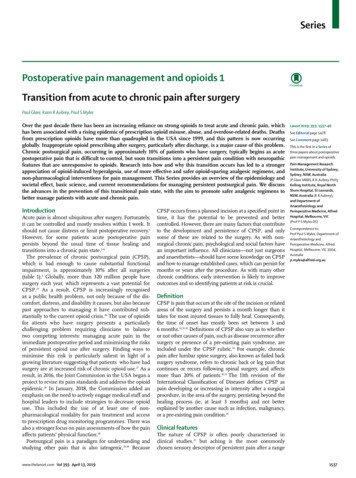
Transcription
SeriesPostoperative pain management and opioids 1Transition from acute to chronic pain after surgeryPaul Glare, Karin R Aubrey, Paul S MylesOver the past decade there has been an increasing reliance on strong opioids to treat acute and chronic pain, whichhas been associated with a rising epidemic of prescription opioid misuse, abuse, and overdose-related deaths. Deathsfrom prescription opioids have more than quadrupled in the USA since 1999, and this pattern is now occurringglobally. Inappropriate opioid prescribing after surgery, particularly after discharge, is a major cause of this problem.Chronic postsurgical pain, occurring in approximately 10% of patients who have surgery, typically begins as acutepostoperative pain that is difficult to control, but soon transitions into a persistent pain condition with neuropathicfeatures that are unresponsive to opioids. Research into how and why this transition occurs has led to a strongerappreciation of opioid-induced hyperalgesia, use of more effective and safer opioid-sparing analgesic regimens, andnon-pharmacological interventions for pain management. This Series provides an overview of the epidemiology andsocietal effect, basic science, and current recommendations for managing persistent postsurgical pain. We discussthe advances in the prevention of this transitional pain state, with the aim to promote safer analgesic regimens tobetter manage patients with acute and chronic pain.IntroductionAcute pain is almost ubiquitous after surgery. Fortunately,it can be controlled and mostly resolves within 1 week. Itshould not cause distress or limit postoperative recovery.1However, for some patients acute postoperative painpersists beyond the usual time of tissue healing andtransitions into a chronic pain state.2–6The prevalence of chronic postsurgical pain (CPSP),which is bad enough to cause substantial functionalimpairment, is approximately 10% after all surgeries(table 1).6 Globally, more than 320 million people havesurgery each year, which represents a vast potential forCPSP.25 As a result, CPSP is increasingly recognisedas a public health problem, not only because of the dis comfort, distress, and disability it causes, but also becausepast approaches to managing it have contrib uted sub stantially to the current opioid crisis.26 The use of opioidsfor atients who have surgery presents a particularlychallenging problem requiring clinicians to balancetwo competing interests: managing acute pain in theimmediate post operative period and minimising the risksof persistent opioid use after surgery. Finding ways tominimise this risk is particularly salient in light of agrowing literature suggesting that patients who have hadsurgery are at increased risk of chronic opioid use.27 As aresult, in 2016, the Joint Commission in the USA began aproject to revise its pain standards and address the opioidepidemic.26 In January, 2018, the Commission added anemphasis on the need to actively engage medical staff andhospital leaders to include strategies to decrease opioiduse. This included the use of at least one of nonpharmacological modality for pain treatment and accessto prescription drug monitoring programmes. There wasalso a stronger focus on pain assessments of how the painaffects patients’ physical function.28Postsurgical pain is a paradigm for understanding andstudying other pain that is also iatrogenic.29,30 Becausewww.thelancet.com Vol 393 April 13, 2019CPSP occurs from a planned incision at a specified point intime, it has the potential to be prevented and bettercontrolled. However, there are many factors that contributeto the development and persistence of CPSP, and onlysome of these are related to the surgery. As with nonsurgical chronic pain, psychological and social factors havean important influence. All clinicians—not just surgeonsand anaesthetists—should have some knowledge on CPSPand how to manage established cases, which can persist formonths or years after the procedure. As with many otherchronic conditions, early intervention is likely to improveoutcomes and so identifying patients at risk is crucial.Lancet 2019; 393: 1537–46See Editorial page 1478See Comment page 1483This is the first in a Series ofthree papers about postoperativepain management and opioidsPain Management ResearchInstitute, University of Sydney,Sydney, NSW, Australia(P Glare MBBS, K R Aubrey PhD);Kolling Institute, Royal NorthShore Hospital, St Leonards,NSW, Australia (K R Aubrey);and Department ofAnaesthesiology andPerioperative Medicine, AlfredHospital, Melbourne, VIC(Prof P S Myles DS)Correspondence to:Prof Paul S Myles, Department ofAnaesthesiology andPerioperative Medicine, AlfredHospital, Melbourne, VIC 3004,Australiap.myles@alfred.org.auDefinitionCPSP is pain that occurs at the site of the incision or relatedareas of the surgery and persists a month longer than ittakes for most injured tissues to fully heal. Consequently,the time of onset has mostly been set between 3 and6 months.22,31,32 Definitions of CPSP also vary as to whetheror not other causes of pain, such as disease recurrence aftersurgery or presence of a pre-existing pain syndrome, areincluded under the CPSP rubric.32 For example, chronicpain after lumbar spine surgery, also known as failed backsurgery syndrome, refers to chronic back or leg pain thatcontinues or recurs following spinal surgery, and affectsmore than 20% of patients.16,33 The 11th revision of theInternational Classification of Diseases defines CPSP aspain developing or increasing in intensity after a surgicalprocedure, in the area of the surgery, persisting beyond thehealing process (ie, at least 3 months) and not betterexplained by another cause such as infection, malignancy,or a pre-existing pain condition.34Clinical featuresThe nature of CPSP is often poorly characterised inclinical studies,35 but aching is the most commonlychosen sensory descriptor of persistent pain after a range1537
SeriesAny intensity Moderate-severe Prevalence (%);(%)intensity (%)prevalence ifrestricted to asevere painratingNumber ofoperations in USnon-federalcommunityhospitals* in 20147Amputation of limb30–85%Not availableArthroplasty, knee13–44%Caesarean section6–55%5–10%15%5–10%Up to 85%844% (15%)9723 086Up to 12%101 142 680Cholecystectomy3–50%11Not reportedNot reportedCraniotomy0–65%1225%12–16%13Hip replacementInguinal hernia repair27%6%27% (15%)9487 625Not 36% 16,17Mastectomy11–57%5–10%22%18Coronary artery bypass graft30–50%5–10%28% (4%)19Laminectomy and spinalfusionThoracotomy5–65%10%300 245Not available48%20,21564 911Not available160 240Not available*Non-federal community hospitals account for 786 874 (87%) of 902 202 hospital beds in the USA.Table 1: Prevalence of chronic postsurgical pain in common surgeries in the USA11,22–24of different surgical procedures.9 Neuropathic descriptorssuch as hyperalgesia (heightened sensitivity to painfulstimuli), dysaesthesia (an unpleasant, abnormal sense oftouch), and allodynia (sensitivity to normally non-painful,often repetitive, stimulation) are frequently used. Thesedescriptors suggest that nerve damage during the surgeryis the cause, with the development of a sensitised centralnervous system due to prolonged afferent traffic (eg, asa result of ongoing inflammation arising from animplant or due to wound infection).36 It now appears thatboth peripheral and central sensitisation occur after anincision, with central sensitisation occurring in both thespinal cord and the brain, and unique mechanisms areinvolved that might yield novel drug targets.37 In a survey3–4 years after surgery, neuropathic descriptors wereused less commonly after hip (1%) and knee replace mentsurgery (6%),38 suggesting that other pain-generatingmechanisms are involved.A common feature of CPSP is that the painfulsensations change from the familiar acute postoperativepain that is injury related and wound focused to acomplex, multifaceted pain syndrome that can increasein intensity in the days, weeks, and then months after thesurgical procedure.39 Because CPSP also commonlyoccurs following surgeries for cancer, the possibility oflocal recurrence needs to be kept in mind.40 Like otherchronic pain, CPSP rarely occurs in isolation but clusterswith other symptoms, including pain-related inter ference with mood (28%), sleep (30%), and enjoyment oflife (30%).41 Psychological factors are also consistentlyassociated with CPSP, including anxiety, depression,pain catastrophising, and general psychological distress.Epidemiology: incidence and prevalenceThe definitional issues related to chronology and whetherrecurrence of pre-existing pain is included have hampered1538definitively establishing the true incidence and prevalenceof CPSP. Methodological issues related to data collectionhave also contributed to this situation. Most studies reporton data collected in a single institution or at a national levelbut this can be problematic, for different reasons.42 Singleinstitution studies use patient-based data from theperioperative period, are often limited to one specific typeof surgery, and include only small samples.43 Nationwidestudies have followed large samples of patients, but havemostly collected retrospective data and therefore are ofdoubtful general validity. To improve our understanding ofthe incidence of CPSP and the associated risk factors, largeprospective international studies that use standardisedmethods to record surgical and other perioperativecharacteristics, including analgesic use, are needed.Because pain is both a sensory and an emotionalexperience, psychological factors such as mood, disabilityand pain coping (eg, pain self-efficacy and paincatastrophising) should also be measured using vali dated standardised questionnaires. Ethnic, cultural, andlinguistic differences in expressing pain and distressmight need to be stratified for in an international survey,but how these factors interact with other psychosocialissues is not well understood.44Notwithstanding these limitations, the extent of theproblem of CPSP has been increasingly recognisedover the past two decades. A report, published in 1998,described 5130 patients who attended ten outpatient painclinics in the UK, and found that CPSP was present inalmost one in four patients.45 A cross-sectional survey ofall adults living in Tromso, Norway (population 75 000),found that 826 (40%) of 2043 patients who recalled havinghad surgery between 3 and 36 months ago reportedongoing pain in the operated area.46 This study alsorevealed that CPSP accounted for approximately a third ofchronic pain cases in the community. However, otherstudies have indicated that CPSP is less common,affecting approximately 10% of people at 1 year aftermajor surgery,2,3,47,48 and is intolerable in 1%.49 In aPortuguese cross-sectional epidemiological study, only91 (6%) of 2213 patients with chronic pain attributed itscause to surgery.50 It has been estimated that 20% ofchildren experience CPSP 1 year after surgery.51 Althoughits exact incidence is unknown, CPSP is far morecommon than most other postsurgical complications andhas long-term consequences. The health-care resourceimplications of CPSP should not be underestimated.CPSP has been reported after almost all types of surgery,with a high prevalence ( 20%) reported after thoracic,breast, inguinal hernia, lumbar spine, and hip or kneearthroplasty surgery (table 1).4,16,33,52–54 Persistent pain is alsocommon after surgery for trauma and burns surgery.55,56The reason for the high prevalence of CPSP after theseprocedures has been attributed to the increased risk ofnerve injury,4 but there could be other explanations,including not only central sensitisation,37 but alsocontinuation of pre-existing pain in the operated area.57www.thelancet.com Vol 393 April 13, 2019
SeriesFurthermore, CPSP follows minor surgeries, despiteevolution in surgical techniques. For example, introductionof minimally invasive approaches such as laparoscopyhave only slightly reduced the prevalence of CPSP.35,58Natural history and prognosis of CPSPWithout large, long-term, prospective studies, the naturalhistory and prognosis of CPSP is hard to predict. On thebasis of data in table 1 CPSP does appear to often resolveby the end of the first year. In one study,42 the syndromewas reported to be present 12 months after surgery in 315(14%) of 3120 patients, being moderate in 12% and severein 2%. In the aforementioned Tromso study,46 40% ofpatients reported CPSP an average of 18 months aftersurgery, and 18% rated it as moderate or severe. Studies44in children have identified several postoperative paintrajectories. Acute postoperative pain got better, worse, orstayed the same; and 10% of children with little or no paininitially had moderate to severe pain up to 5 years later.59Mechanisms of transition from acute to CPSPSome molecular mechanisms responsible for thetransition of acute to chronic pain and their neuro biological correlates have been identified in animalmodels of chronic pain.60–65 The sensory aspects of painare carried by a bidirectional network of neurons thattransmits a variety of noxious signals from peripheralnociceptive Aδ-fibres and C-fibres to the dorsal horn ofthe spinal cord (SCDH). Here, noxious signals are passedto ascending projection neurons that convey them to thecortex via the thalamus. Noxious signals are modulatedand shaped at every level of the nervous system, includingpowerful descending pain pathways (figure 1). Morecomplete reviews of the mechanisms that contribute tochronic pain are available.63,65–67(eg, the gabapentinoids) preoperatively or perioperativelyto try to prevent CPSP, and reduce opiate use after surgeryhave had mixed success. Diverse outcomes are likelyrelated to innate differences in surgeries, and psycho socialrisk factors. Additionally, the inhibitors used are not highlyspecific for pain circuits or their target proteins. Moreconsistent results, with fewer side-effects, might resultfrom targeted drug delivery to nociceptive neurons duringsurgery.A promising strategy, which could be used duringsurgery, is to interfere with the messenger RNA mediatedcascade of pain-induced protein synthesis that occursfollowing injury. This is achieved by injecting a highlystable decoy RNA-binding protein into the site of injury atthe time of injury. This strategy has been tested in a varietyof mouse models of inflammatory sensitisation, and thedecoy RNA-binding protein reduced the behaviouralcorrelates of central sensitisation and increased the rate ofrecovery from sensitisation in the hours and daysfollowing the inflammatory challenge.75AMidbrainAscending analgesicpathwayCorticolimbic regions(emotion and reward)activated by this pathwaymight be altered in peoplewith chronic pain PAGMedulla RVMSpinal cordSCDHNociceptive afferents and the SCDHTissue damage during surgery plays a definitive role in thedevelopment of CPSP, and triggers profound changes inperipheral and central somatosensory circuits. Nociceptiveinputs into the SCDH release the neuro transmitterglutamate, which acts at specific receptors, ropionic acid re cep tors and the frequently implicated N-methyl-Daspartate receptors (NMDARs).68 Following nerve injury,nociceptive neurons fire rapidly leading to changes inNMDAR composition and activation. NMDARs are highlypermeable to calcium, whose influx triggers neuronspecific cascades that underlie synaptic plasticity and, inextreme cases, cause excitotoxicity and neuronal death.69 Ina neuro pathic pain model, the conditional deletion ofspinal NMDARs prevents calcium-dependent neuronaldeath and the transition from acute to persis tent pain-like behaviours. This shows that glutamate,NMDARs, and calcium influx play an essential role in thedevelopment of chronic pain.69 Multiple studies70–74 thathave inhibited NMDAR or voltage-gated calcium channelswww.thelancet.com Vol 393 April 13, 2019Descending analgesicpathwayPreventing activation ofthis pathway can preventthe development ofchronic neuropathic painin animal models BSCDHAfter nerve injury,some neurons inthe SCDH undergoNMDAR mediatedexcitotoxicityPrimary afferentnociceptorsInjury-inducedprotein synthesis inDRGs contributesto centralsensitisationAMPARNa2 AxonCa2 -dependent processesCa2 NMDARFigure 1: Neural pathways for painFundamental changes to neuronal phenotypes and brain circuits occur whenpain becomes chronic. These changes can alter sensory, emotional, andmotivational centres of the brain and interfere with the action of traditionalanalgesic medications. A complete understanding of how these circuits work inacute and chronic pain is needed before we can prevent or treat chronic pain.(A) Schematic diagram of the ascending and descending pain pathways showingtreatment possibilities. Injecting tetrahydrocannabinol or cannabidiol into thePAG, RVM, or SCDH is analgesic in animal models of neuropathic pain (stars).(B) A glutamate releasing synapse with calcium permeable NMDA receptors.AMPAR α-amino-3-hydroxy-5-methyl-4-isoxazole-propionic acid receptors.Ca² calcium. DRG dorsal root ganglia. Na² sodium.NMDAR N-methyl-D-aspartate receptors. PAG periaqueductal grey.RVM rostral ventromedial medulla. SCDH dorsal horn of the spinal cord.1539
SeriesSubgroup withworse CPSPConsistency Timing of data collectionof evidencePreoperative Intraoperative PostoperativeDemographicAgeYounger adultsConsistent ····GenderFemaleMixed ····Marital status or livingarrangementsSingle or livingaloneMixed ······Education levelLess educatedConsistent····Employment statusUnemployedMixed······Compensation estyleSmokersConsistent······Gene mutationsVarious single genecandidates(eg, COMT, OPRM1,GCH1)Few data /–······ClinicalMedical comorbiditiesMoreConsistent ··Body-mass indexHigherMixed ····Prior disabilityGreaterConsistent ······Surgery relatedDuration of surgeryLongerConsistent·· Surgical techniqueNerve injuryMixed·· ··Analgesia regimenSystemic, reactive vs Mixedspinal, pre-emptive ··AnaesthesiaGeneral vs regionalMixed·· ··ComplicationsMoreConsistent·· PainConsistent······Postoperative, intensity StrongerPreoperativePresentConsistent Postoperative, duration 5 daysConsistent PsychologicalFear or anxietyGreaterConsistent ·· DepressionGreaterConsistent ·· Pain catastrophisingGreaterConsistent ·· Other psychologicalissues (eg, vulnerabilityfactors)PresentFew data······WorseConsistent ·· Physical functioningPain interferenceCPSP chronic postsurgical pain. COMT catechol-O-methyltransferase. OPRM1 opioid receptor mu 1.GCH1 guanosine-5’-triphosphate cyclohydrolase 1. appropriate timing of data collection. /–The Initiative on Methods,Measurement, and Pain Assessment in Clinical Trials expert panel acknowledged that many studies of CPSP might not bedesigned or have sufficient power to test genetic hypotheses. In these cases, collection and storage of biological samplesfor future genotyping is strongly recommended.Table 2: Proposed domains, constructs, and timing of data collection in future studies of chronicpostsurgical pain23,104,105CannabinoidsCannabinoids, including the two predominant constituentsof marijuana tetrahydrocannabinol and cannabidiol,modulate nociceptive signals76 and might have a role inthe treatment of CPSP.77 The few clinical trials78,79 that haveovercome the ongoing legal barriers to doing human trialson cannabinoids in chronic pain have not identified a1540major analgesic advantage, although consistent improve ments in sleep and mood have been reported. Animal dataindicate that cannabinoids have efficacy for neuro pathicpain;80–83 however, there is a scarcity of firm clinical data.Additionally, synergistic pain relief has been reportedwith low doses of tetra hydrocannabinol and cannabidiol,81,84and with canna binoids and morphine.85 Therefore,combination cannabinoid therapies could effectivelyprevent acute postoperative pain in surgical patients witha high risk of nerve damage, but there remains someconcern about their side-effects.86Descending modulationThe most studied descending pain pathway projects fromthe midbrain periaqueductal grey (PAG) to the rostralventromedial medulla (RVM), which sends inputs directlyonto nociceptive neurons in the SCDH.87 This pathway hasthe ability to strongly influence the pain experience; forexample, electrical stimulation of the PAG blocks spinalresponses to noxious stimuli, and simulation of theRVM can both inhibit and facilitate pain signals.88 Thisdescending pathway plays an essential role in thedevelopment of chronic pain following nerve damage,because lesions to the site where descending pain fibresenter the spinal cord can prevent the development ofneuropathic pain in animal models,87,89–95 which suggeststhat avoiding PAG-RVM involvement during some periodafter surgery could reduce the incidence of CPSP.64An animal study that used genetic technologies found thatselective activation of a subset of RVM neurons that releaseγ-aminobutyric-acid increased responses to mechanicalstimulation (hyperalgesia) without changing responses tothermal stimuli. By contrast, turning off these sameneurons reduced mechanical responses (hypoalgesia) andwhen animals were subjected to long periods of stress,these neurons were activated and mechanical hyper sensitivity was enhanced.96,97 The study shows that justone small descending circuit can set pain thresholds, andinhibit and facilitate responses to noxious mechanicalstimulus. Additionally, this circuit responds differently tolong and short periods of stress and might be part of amechanism that explains why patients with pre-existingstress have a higher risk of developing CPSP.Behavioural correlatesNeuroimaging in humans has shown that brain regionsassociated with emotions and motivation are activatedduring noxious stimulation and these regions can bealtered in structure, activity, or connectivity in patientswith chronic pain.62 A study89,99 that followed up patientswith acute back pain for 3 years found that the anatomicalcharacteristics of corticolimbic circuitry (responsible foremotion and reward) are the dominant predictor (60% ofthe variance) for patients who developed chronic pain.This finding suggests that associative circuits are moreimportant than pain-related ones for the developmentof chronic pain and thus should be the major focuswww.thelancet.com Vol 393 April 13, 2019
Seriesof research and therapeutic interventions.100 Addictivesubstances such as opioids alter the plasticity of thecorticolimbic circuits, and conversely, persistent painpromotes opiate reward.101 The increase in opiate rewardmeasured in mice with neuropathic pain was specificallydependent on signalling changes in a group of cortico limbic neurons that contain the peptide hormonecorticotropin-releasing factor. This finding mechanis ticallylinks synaptic plasticity induced by chronic pain tobehavioural susceptibility to increased opiate reward102 andsuggests that therapeutic strategies that seek to normalisecorticolimbic connectivity could improve chronic pain andopiate use outcomes.Our neurobiological understanding of pain suggests thatnoxious signals are integrated by multiple distinct andoverlapping neuronal populations and brain regions.Researchers are only just beginning to unravel thesecomplex circuits and interactions to understand when andhow they shape and scale sensory input and how theirrelative contributions affect the experience of pain.103Because of the various factors that can contribute tothe development of chronic pain, a single treatment isunlikely to be effective and appropriate for all patients withchronic pain. CPSP has an advantage from a researchperspective of occurring in response to a known injury.Biomedical and psychological testing before and after thenociceptive challenge can be assessed and potentialtherapeutic compounds could be locally delivered to thesite of injury before and during surgery.Predictors of CPSPThe ability to predict who is at risk of developing CPSP isclearly important, especially if the risk factors aremodifiable. Despite the progress in understanding thetransition from acute to chronic pain, the research to datemainly identifies clinical risk factors. This literature issummarised in table 2. To facilitate future research inthis field, a standardised approach to data collection ofpatient-reported and clinical outcomes has been proposedby the Initiative on Methods, Measurement, and PainAssess ment in Clinical Trials (IMMPACT) and is outlinedin panel 1.104 Five core risk factor domains havebeen identified: demographic, genetic, clinical, sur geryrelated, and psychological. Four outcome domains havebeen identified, with standardised validated tools formeasuring them: pain, physical functioning, psycho logicalfunctioning, and global rating of outcome. Standardisationof the definition of CPSP and uniformity in the timingof follow-up to assess transition from acute to chronic painat multiple timepoints are other methodological issuesthat have been emphasised in this Series.Risk factors for CPSP are not independent of each other,but interlinked.23 For example, preoperative chronic pain ismore common in women, and sensitivity to experimentalpain stimuli is often accompanied by mood disorders suchas depression and anxiety. It is therefore not surprising thatpatients with established chronic pain and pain-relatedwww.thelancet.com Vol 393 April 13, 2019Panel 1: Risk factors for chronic postsurgical painDemographics and lifestyle Age Gender Marital status or living arrangements Education level Employment status Compensation status Obesity SmokingGenetic Candidate gene mutations associated with increased pain(eg, COMT,OPRM1, and GCH1)Clinical Surgical factors, including surgical technique (open vslaparoscopic), duration of surgery, type of anaesthesia(general vs regional), and perioperative Analgesic regimen (systemic vs spinal and pre-emptive);surgical complications and re-operating Medical comorbidities Previous disability or pain interferencePreoperative pain (area of operation or elsewhere)Postoperative pain (intensity and duration)Psychological Fear or anxiety Depression Pain catastrophising Other psychological issues (eg, vulnerability factors)COMT catechol-o-methyltransferase. OPRM1 opioid receptor mu 1.GCH1 guanosine-5’-triphosphate cyclohydrolase 1.behaviours are more likely to report increased acutepostoperative pain that is often difficult to treat becauseof tolerance and opioid-induced hyperalgesia from theirprevious treatment of chronic pain with high-dose opioids.Predictive toolsBecause there are multiple, interacting risk factors fordeveloping CPSP, attempts have been made to developpredictive tools that quantify the level of composite risk.Most have been operation specific, but one generic toolevaluated the effect of 14 biomedical and psychosocialitems that were derived from a systematic review of theCPSP risk factor literature.106 From a training set of150 patients, of whom almost half developed CPSP, five ofthe 14 items were independently predictive of developingCPSP, of which four are assessable pre operatively (painin the surgical field, comorbid chronic pain at othersites, capacity overload, and comorbid stress) and onepostoperatively (moderate to severe postoperative painpersisting at day 5). Because the five risk factors were ofsimilar importance (odds ratios all approximate ly 2–3),1541
SeriesPanel 2: Design issues for studies evaluating interventions that aim to prevent thedevelopment of transitional and chronic postsurgical pain105Patient population Initial focus on surgeries with high likelihood of chronic postsurgical pain(eg, amputation, mastectomy, thoracotomy, and herniorrhaphy) Ideally surgeries for painful conditions, or in sites of pre-existing pain If intervention is effective, broaden focus to other surgical populationsRisk factors Need to be adjusted and stratified for (see table 2)Timing of preventive intervention Commence treatment early enough (eg, sometimes weeks before surgery) Continue for duration of acute postoperative pain and the transitional phase, if possibleand feasibleOutcome measure Consider how pain presence, intensity, quality, and aggravating factors will be measuredTiming of endpoint First outcome score (eg, at 1, 2, or 3 months postoperatively)— depends on type ofsurgery Specify duration of data collection—quarterly for at least 12 months is recommended Measure amount and type of acute postoperative pain Design of follow-up studies influenced by effect of the intervention on acutepostsurgical painthey were each given the same rating to ease scoring inroutine clinical use. Patients with three to five positive riskfactors were more likely to go on to develop CPSP thanwere those with zero to two factors (sensitivity 74%,specificity of 65%). However, as yet no validation studies bythe authors or other reports of clinical use of the tool havebeen published.For specific surgeries, tools have been developed forpredicting chronic post-herniorrhaphy pain and persistentpain after breast cancer surgery.107,108 The hernia surgerytool utilises just two preoperative factors: pain-relatedimpairment score and pain intensity score in response to atonic heat stimulus of 47 C.107 It had fair predictive anddiscriminatory ability. The authors suggested to use thisapproach to direct patients at high risk (severe preoperativeimpairment and high preoperative pain sensitivity) ofCPSP away from open surgery (70% risk) to laparoscopichernia repair (30% risk). However, this tool has not beenwidely used nor further validated.The tool for predicting persistent pain after breast cancersurgery was developed in a training set of 860 patients inFinland and consists of five factors: high body-mass index,preoperative pain in the operative area, axillary lymphnode dissection, maximum
pain after lumbar spine surgery, also known as failed back surgery syndrome, refers to chronic back or leg pain that continues or recurs following spinal surgery, and affects more than 20% of patients.16,33 The 11th revision of the International Classification of Diseases defines CPSP as pain developing or increasing in intensity after a surgical
